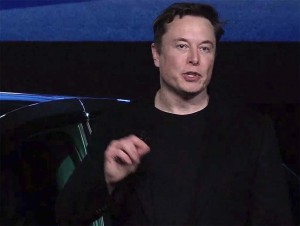
Will Tesla CEO Elon Musk report the company's biggest sales drop — or will he have a surprise in store?
Tesla is expected to report its sharpest downturn in sales ever for the first quarter of 2019, but there’s a slight chance the battery-carmaker could deliver a big surprise.
A key reason why industry analysts are forecasting a slowdown is the ongoing phase-out of the Tesla’s federal tax credits. As of Jan. 1, buyers now receive a maximum $3,750 in incentives, down from $7,500 previously.
Industry prognosticators are expecting Tesla sales to run somewhere between 50,000 and 65,000 vehicles for the quarter. But a new forecasting tool recently launched by Bloomberg puts the number closer to 80,000. Either way, that would mark a significant downturn from the 90,700 vehicles sold during the final three months of 2018.
On the positive side, Tesla sales are likely to come close to doubling te 30,000 vehicles ordered during the first quarter of 2018, when the carmaker was still struggling with what CEO Elon Musk called “production hell” at its Fremont, California assembly line.
(Tesla, SEC set to engage in battle royal over tweet. Click Here for the story.)
Whether the new Bloomberg tracking system proves accurate could be significant, especially for investors, as it could translate into as much as $1 billion in additional revenues.
But even at that higher figure, this would mark the biggest downturn in Tesla’s brief history and raise concerns about its ability to keep demand building at the same time as it’s boosting production capacity at the Fremont plant and preparing to launch a second assembly line in Shanghai. CEO Elon Musk has said that he expects Tesla will be operating at an annualized rate of about 500,000 vehicles by the end of 2019.
There are a variety of factors that could impact Tesla demand. It is burning through those early “reservations” taken when the Model 3 sedan debuted nearly two years ago. It also waited until well into the first quarter before finally launching the long-promised, $37,500 Standard Range Plus version.
But the biggest hit was expected to come from the phase-out of the tax incentives given to Tesla buyers. They had been $7,500 per vehicle but, after Tesla hit a sales threshold of 200,000 vehicles, they were cut in half, to $3,750, as of Jan. 1. They will be halved again in July and eliminated entirely at the end of this year.
Tesla became the first automaker to top that sales hurdle, though General Motors and Nissan will see their own incentives begin to phase out over the coming year.
Tesla has tried to offset the loss of incentives by, among other things, launching the Model 3 Standard Range Plus, while also cutting prices by $2,000 at the beginning of the year.
Even if that won back some potential Tesla buyers the company recently acknowledged there was likely some “pull forward,” buyers who decided to buy one of its battery-cars during the fourth quarter to avoid losing half the tax credits.
The slowdown in sales will have a direct impact on the bottom line of a company that delivered two rare quarterly profits during the second half of 2018.
(Click Here for details about Tesla suing a former employee for theft.)
After initially predicting another profit for Q1, Musk has now reversed himself, saying Tesla will likely fall back into the red.
In an email sent to employees in February, he asked they help do everything possible to boost deliveries before the end of March. “As challenges go, this is a good one to have, as we’ve built the cars and people have bought the cars,” he wrote. “So we just need to get the cars to their new owners!”
Investors will be watching for signs that the first-quarter slowdown won’t last. The automaker has been draining what had been $3.7 billion in cash reserves before paying off $920 million in bond debt last month. It has another payment of $566 million due in November, and will have to meet $1.4 billion in obligations in 2021.
“From our standpoint we wouldn’t characterize Tesla as having a robust liquidity position by any means, but it’s less tenuous than it was six to nine months ago,” said Bruce Clark, credit analyst at Moody’s.
Were Tesla to deliver stronger-than-expected first quarter sales results that would likely soften concerns.
Another factor that may have suppressed the numbers is the slow delivery of vehicles to markets overseas. But the new Bloomberg forecasting tool indicates overseas sales have been seriously underestimated. European demand is booming, sales in Norway growing so fast that electric vehicles, overall, accounted for 58% of the new vehicles registered in March.
On the other hand, Tesla shipments were held up at the port in Belgium due to a strike and China temporarily held back new Model 3 deliveries after discovering inaccurate labels on some of those vehicles.
(Tesla reverses position – will keep some stores open. Click Here for the latest.)
Which forecast proves correct could have a significant impact on how the market responds once Tesla releases its first-quarter numbers later today.
